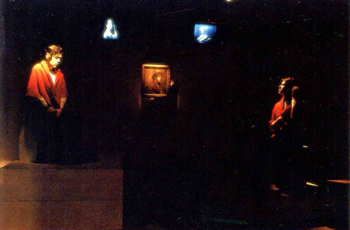“SURVEILLANCE” 1978

ART PRESS 'Surveillance' operates on a principal of exponential growth in meaning which happens on many levels simultaneously, both in what is being revealed, and in the medium of its expression. The title is an example of this rendering a wealth of significance and word-play. So is the way in which Garrard plays with space, moving from two dimensions to three, to the multiples created by video, and then stretching this framework of space into her own past and future with the subject matter of the work, her personal history and her exploration of self-images. The same observations can be made of her presentation of time, for the biographical material is elusive because it's fast moving and full of double meanings, and the sound tape and video facilitate a complex use of synchronised time-delay, structurally (what we hear is different from what we see) and referentially (past, present and future) But the revelation of self-imagery is only the starting point of 'Surveillance'. It has the characteristic strength of much women's art to illuminate public issues through the focus of private experience. And, again, the structure facilitates this in a direct and economical way. Images of women necessarily predominate, but the examination of female identity comprehends the male role (as father, portrait painter, art historian who assumes the picture to be painted by a man, as 'other', as male painter of women). Images of women on video key instantly into cultural role-play, advertising and the media. The personal language of dress, of dressing up for social roles, of projecting a desired identity or feeling trapped within one are also inseparable from the industries and media which use (or abuse) this language ...
If 'Surveillance' can be said to be about anything, it is about power and the manipulation of power through signs and communication systems, and like the most successful radical practitioners in other fields, Garrard achieves purity (the freedom of the expert to pursue knowledge as far as is possible) and social accessibility (in the radical sense) simultaneously without uneasy division. Her conversation after the performance centred round two issues, her gender and her willingness to confront ambiguity, and she was clear that she works in an area which is beyond gender, beyond the exclusive categories of sexual politics in the same way that she has moved away from the traditional restrictive practices of painting and sculpture. That her long standing interest in the arts of self image making, and image projection is used to raise questions not to answer them; to facilitate understanding, not to make judgments. And that her interest in ambiguity is in its power to reveal truths not to mask them. This did communicate during the performance by her presentation of self, not only a manipulator of power, but as a person upon whom power has a manipulative effect. Victim as well as hero, caught in the network of lines as well as creator of it. Exploder of mysteries of social control.
Dinah Dossor, Performance, January 1981
ARTIST'S NOTES The space is in heavy shadow. A painting of a young woman hangs in a shaft of sunlight in the hall, opposite the window. The painting used to hang in the hall, or was it the kitchen? It was not the best painting in the house. It is unsigned, unfinished, and damaged. But it is the painting I chose to take with me when I left.
The 'key' object in this installation is the 19th century framed portrait, which becomes both the subject matter and the content of the work. The word 'Concours' - competitive examination which is written on the canvas, triggered memories of competitiveness and lack of it, perfection and imperfection, and role playing in my own upbringing. These were supplemented by my feelings as an artist (active surveyor) and as a young girl (passive model), which were clarified by trying to objectify why I had chosen to take that particular painting with me when I left home. I named the piece 'Surveillance'.
Rose Garrard, 'Lives', Arts Council of Great Britain, 1979
SITES
'Hayward Annual' Hayward Gallery London
'Lives' Arts Council Purchase exhibition Serpentine Gallery London
Chapter Arts Centre Cardif Wales
'Symposium of International Performance' Lyon France
COMPONENTS
Script, soundtrack, painted portrait and life-size fibreglass and resin figure/model, two surveillance cameras linked to two monitors. Artist as model and performer
COLLECTION
Arts Council of Great Britain 1997